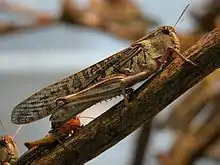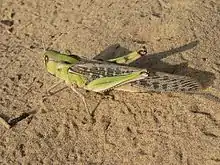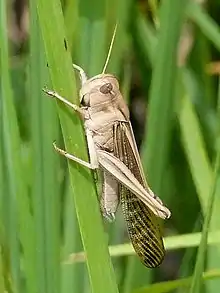Migratory locust
The migratory locust (Locusta migratoria) is the most widespread locust species, and the only species in the genus Locusta. It occurs throughout Africa, Asia, Australia and New Zealand. It used to be common in Europe but has now become rare there. Because of the vast geographic area it occupies, which comprises many different ecological zones, numerous subspecies have been described. However, not all experts agree on the validity of some of these subspecies.
| Migratory locust | |
|---|---|
 | |
| Female migratory locust | |
| Scientific classification | |
| Kingdom: | Animalia |
| Phylum: | Arthropoda |
| Class: | Insecta |
| Order: | Orthoptera |
| Suborder: | Caelifera |
| Family: | Acrididae |
| Subfamily: | Oedipodinae |
| Genus: | Locusta Linnaeus, 1758 |
| Species: | L. migratoria |
| Binomial name | |
| Locusta migratoria | |
| Synonyms | |
| |
Many other species of grasshopper with gregarious and possibly migratory behaviour are referred to as 'locusts' in the vernacular, including the widely distributed desert locust.
At 6.5 Gbp,[1] the migratory locust possesses one of the largest known insect genomes.[2]
Polyphenism
The migratory locust is polyphenic. It transitions between two main phenotypes in response to population density; the solitary phase and the gregarious phase. As the density of the population increases the locust transforms progressively from the solitary phase towards the gregarious phase with intermediate phases:
- Solitaire = solitary phase → transiens congregans (intermediate form) → gregarious phase → transiens dissocians (intermediate form) → solitaire = solitary phase.
Pigmentation and size of the migratory locust vary according to its phase (gregarious or solitary form) and its age. Gregarious larvae have a yellow to orange covering with black spots; solitary larvae are green or brown. The gregarious adult is brownish with yellow, the latter colour becoming more intense and extensive on maturation. The solitary adult is brown with varying extent of green colour depending on the colour of the vegetation. Gregarious adults vary in size between 40 and 60 mm according to the sex; they are smaller than the solitary adults.
The phase transition may be mediated by DNA methylation in the brain. Expression of the DNA methyltrasferase gene Dnmt3 is high in the brain of the gregarious form, decreases in gregarious locusts when they are isolated, and increases in solitary locusts when they are crowded. Knock-down reduces phase-related locomotor activity.[3] Transcriptionally, Dnmt3 is linked with phase-core transcriptional factor, hormone receptor HR3.[3]
Relationship with humans
Economic impact
_b_585.jpg.webp)
Locusts are highly mobile, and usually fly with the wind at a speed of about 15 to 20 kilometres per hour (9.3 to 12.4 mph). Swarms can travel 5 to 130 km or more in a day. Locust swarms can vary from less than one square kilometre to several hundred square kilometres with 40 to 80 million individuals per square kilometre. An adult locust can consume its own weight (several grams) in fresh food per day. For every million locusts, one ton of food is eaten.
In Africa, the last serious widespread plague of L. m. migratorioides occurred from 1928 to 1942. Since then, environmental transformations have made the development of swarms from the African migratory locust unlikely. Nevertheless, potential outbreaks are constantly monitored as plagues can be devastating. The Malagasy migratory locust (L. m. capito) still regularly swarms (roughly twice every ten years). The desert locust, which is very similar to the African migratory locust, remains a major threat too.
Locust survey and control are primarily the responsibility of the Ministry of Agriculture in locust-affected countries and are operations undertaken by national locust units. The Food and Agriculture Organization (FAO) of the United Nations provides information on the general locust situation to all interested countries and gives warnings and forecasts to those countries in danger of invasion.
As food / edibility
The migratory locust is an edible insect.[4][5] In Europe, the migratory locust is officially approved for the use in food in Switzerland (since May 2017).[6]
Subspecies of Locusta migratoria


L. migratoria is found over a vast geographic area, and its range covers many different ecological zones. Because of this, numerous subspecies have been described; however, not all experts agree on the validity of some of these subspecies.[7]
- L. m. burmana Ramme, 1951
- L. m. capito Saussure, 1884 (Malagasy migratory locust: Madagascar)
- L. m. cinerascens Fabricius, 1781 (Italy, Spain)
- L. m. manilensis (Meyen, 1835) 1 (eastern Asia)
- L. m. migratoria (Linnaeus, 1758) (Eurasian migratory locust: West and Central Asia, eastern Europe)
- L. m. migratorioides (Fairmaire & L.J. Reiche, 1849) (African migratory locust: Africa and Atlantic islands)
- L. m. tibetensis Chen, Yonglin, 1963
- L. m. danica (Linnaeus, 1767) = L. m. migratoria (Linnaeus, 1758)
- L. m. gallica Remaudičre, 1947 = L. m. migratoria (Linnaeus, 1758)
- L. m. solitaria Carthy, 1955 = L. m. migratoria (Linnaeus, 1758)
Other species called 'locusts'
Other species of Orthoptera that display gregarious and migratory behaviour are called 'locusts'.
- American locust, Schistocerca americana
- Australian plague locust, Chortoicetes terminifera
- Bombay locust, Nomadacris succincta
- Brown locust, Locustana pardalina
- Desert locust, Schistocerca gregaria
- Egyptian locust, Anacridium aegyptium
- Italian locust, Calliptamus italicus
- Moroccan locust, Dociostaurus maroccanus
- Red locust, Nomadacris septemfasciata
- Rocky Mountain locust, Melanoplus spretus – extinct
- Sahelian tree locusts, Anacridium melanorhodon
- Spur-throated locust, Austracris guttulosa (note: "spur-throated grasshoppers/locusts" may also refer to spp. in other genera)
- Sudan plague locust, Aiolopus simulatrix
The Senegalese grasshopper (Oedaleus senegalensis) also often displays locust-like behaviour in the Sahel region.
Photos
 First instar nymph (gregarious)
First instar nymph (gregarious) Second and fourth instar nymphs (gregarious)
Second and fourth instar nymphs (gregarious) Third instar nymphs (gregarious)
Third instar nymphs (gregarious) Fourth instar nymph (gregarious)
Fourth instar nymph (gregarious) Part of a hopper band in Kazakhstan
Part of a hopper band in Kazakhstan Hopper band in Kazakhstan
Hopper band in Kazakhstan
Footnotes
- Wang, Xianhui; Fang, Xiaodong; Yang, Pengcheng; Jiang, Xuanting; Jiang, Feng; Zhao, Dejian; Li, Bolei; Cui, Feng; Wei, Jianing; Ma, Chuan; Wang, Yundan; He, Jing; Luo, Yuan; Wang, Zhifeng; Guo, Xiaojiao; Guo, Wei; Wang, Xuesong; Zhang, Yi; Yang, Meiling; Hao, Shuguang; Chen, Bing; Ma, Zongyuan; Yu, Dan; Xiong, Zhiqiang; Zhu, Yabing; Fan, Dingding; Han, Lijuan; Wang, Bo; Chen, Yuanxin; Wang, Junwen; Yang, Lan; Zhao, Wei; Feng, Yue; Chen, Guanxing; Lian, Jinmin; Li, Qiye; Huang, Zhiyong; Yao, Xiaoming; Lv, Na; Zhang, Guojie; Li, Yingrui; Wang, Jian; Wang, Jun; Zhu, Baoli; Kang, Le (2014). "The locust genome provides insight into swarm formation and long-distance flight". Nature Communications. 5: 2957. Bibcode:2014NatCo...5.2957W. doi:10.1038/ncomms3957. ISSN 2041-1723. PMC 3896762. PMID 24423660.
- Li, Sheng; Zhu, Shiming; Jia, Qiangqiang; Yuan, Dongwei; Ren, Chonghua; Li, Kang; Liu, Suning; Cui, Yingying; Zhao, Haigang; Cao, Yanghui; Fang, Gangqi; Li, Daqi; Zhao, Xiaoming; Zhang, Jianzhen; Yue, Qiaoyun; Fan, Yongliang; Yu, Xiaoqiang; Feng, Qili; Zhan, Shuai (2018). "The genomic and functional landscapes of developmental plasticity in the American cockroach". Nature Communications. 9 (1): 1008. Bibcode:2018NatCo...9.1008L. doi:10.1038/s41467-018-03281-1. ISSN 2041-1723. PMC 5861062. PMID 29559629.
 This article contains quotations from this source, which is available under the Creative Commons Attribution 4.0 International (CC BY 4.0) license
This article contains quotations from this source, which is available under the Creative Commons Attribution 4.0 International (CC BY 4.0) license - Hou, Li; Wang, Xuesong; Yang, Pengcheng; Li, Beibei; Lin, Zhe; Kang, Le; Wang, Xianhui (2020). "DNA methyltransferase 3 participates in behavioral phase change in the migratory locust". Insect Biochemistry and Molecular Biology. 121: 103374. doi:10.1016/j.ibmb.2020.103374. PMID 32283278.
- Oonincx, Dennis G. A. B.; van Itterbeeck, Joost; Heetkamp, Marcel J. W.; van den Brand, Henry; van Loon, Joop J. A.; van Huis, Arnold; Hansen, Immo A. (29 December 2010). "An Exploration on Greenhouse Gas and Ammonia Production by Insect Species Suitable for Animal or Human Consumption". PLOS ONE. 5 (12): e14445. Bibcode:2010PLoSO...514445O. doi:10.1371/journal.pone.0014445. PMC 3012052. PMID 21206900.
- Barsics, F., 2010. L'alimentation des Populations locales de Madagascar productrices de Vers à Soie. - Univ. de Liège.: 1-84.
- Bundesamt für Lebensmittelsicherheit und Veterinärwesen (2017-04-28): "Insects as food" (German only)
- Chapuis, M-P.; Lecoq, M.; Michalakis, Y.; Loiseau, A.; Sword, G. A.; Piry, S.; Estoup, A. (1 August 2008). "Do outbreaks affect genetic population structure? A worldwide survey in a pest plagued by microsatellite null alleles". Molecular Ecology. 17 (16): 3640–3653. doi:10.1111/j.1365-294X.2008.03869.x. PMID 18643881. S2CID 4185861.
References
External links
| Wikimedia Commons has media related to Locusta migratoria. |
